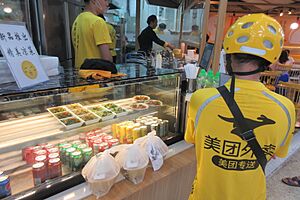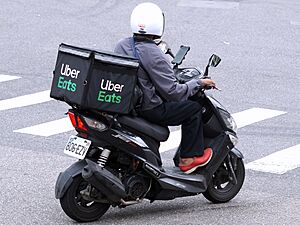Online food ordering facts for kids
Online food ordering is when you order food using a website or an app. You can choose to have the food delivered right to your door or pick it up yourself. This food can be a ready-to-eat meal from a restaurant or even fresh groceries like fruits and vegetables.
Ordering food online, especially through companies that deliver for many different places, has become a huge business all over the world. It has changed how people get their meals.
Contents
How Online Food Ordering Started
The very first online food order was a pizza from Pizza Hut in 1994.
In the U.S., more and more people started ordering food online. About 40% of adults in the U.S. have ordered food this way at least once. This includes meals from restaurants, food made by independent cooks, and even groceries.
The first service made just for ordering food online was called World Wide Waiter (now Waiter.com). It started in 1995. At first, it only served a small part of California, but it soon grew to other cities in the United States.
By the late 2000s, big pizza companies had their own apps for ordering. They found that 20-30% of their orders came from online. As more people got smartphones and services like Uber became popular, new food delivery companies started to get a lot of attention. In 2010, a website called Snapfinger, which let you order from many restaurants, saw its mobile orders jump by 17% in just one year.
By 2015, ordering food online became more popular than ordering by phone.
In China, the online food ordering and delivery market grew a lot in 2015.
By September 2016, about 3% of all restaurant orders in the U.S. were made online.
In 2018, studies showed that online restaurant ordering was growing much faster than people eating inside restaurants. News reports said that ordering online was becoming "the norm" because it was so easy and you could pay right away. Some even thought that getting prepared food delivered regularly might mean people would cook less at home.
A study in 2019 estimated that the global market for online food delivery was worth $94 billion. It was expected to grow to $134.5 billion by 2023. This included food delivered by the restaurant itself, food delivered by a platform like Deliveroo or Uber Eats, and online orders that customers picked up themselves. It did not include orders made over the phone.
After 2020, the COVID-19 pandemic caused a big increase in online food delivery all around the world.
Types of Online Food Ordering
Traditional Delivery Services
For a long time, restaurants and fast-food places have offered delivery or takeout. They often use their own drivers or hire other companies to bring prepared meals directly to customers. Big names like Dominos, Pizza Hut, and Papa John's have been delivering food for many years.
Restaurant-Controlled Ordering
Some restaurants create their own websites and apps for ordering. They make sure they have special software to handle many orders at once. Other restaurants might hire a company to set up their online ordering system. The restaurant pays a fee, and the company handles the technical parts.
Customers can choose to have their food delivered or pick it up. They pick a restaurant, look at the menu, choose their food, and then decide if they want delivery or pickup. They can pay with a credit card or debit card through the app, or sometimes with cash when they pick up the food. The website or app tells the customer how long it will take for their food to be ready or delivered. Papa John's is an example of a restaurant that built its own online ordering system and does its own deliveries. In 2010, they updated their website and launched apps for many different kinds of phones and tablets.
Because these restaurants already had delivery drivers, adding online ordering was easy. In 2010, Papa John's announced that its online sales had gone over $2 billion.
Independent Cook Websites
Sometimes, a person cooks meals or prepares meal kits and sells them directly through their own website. These are then sent to customers' homes or offices. Customers choose what they want and how many meals, and pay based on their choices. People might order from independent cooks if they don't have time to cook, want homemade meals, or want to eat healthy food to lose weight.
Food Cooperatives
Some food cooperatives, like Macomb Co-op, let their members order local food online. Members can then pick up and pay for their orders at a central location.
Delivery Platforms
Companies like Deliveroo and Uber Eats are delivery platforms. They connect customers with many different restaurants. The drivers and riders who work for these services are usually independent contractors. This means they can choose when they want to work.
However, these drivers and riders often don't get things like insurance or sick pay. This has led to some people asking for better safety. For example, Deliveroo gave its riders helmets with cameras to record any problems they might face. Riders can also report safety concerns about delivery areas through the app.
Meal-Kit Delivery Services
Another type of food delivery is meal-kit services. These companies send customers pre-measured ingredients and recipes to cook meals at home. Services like Blue Apron, HelloFresh, and Sun Basket are popular. They are great for people who want to eat healthy or have busy lives. These services offer the ease of food delivery but still let you enjoy cooking at home.
Virtual Restaurants

As online food delivery grew, some businesses started using "delivery-only" restaurants. These are also called ghost kitchens. They are built just for preparing food for delivery, not for customers to eat inside. A ghost kitchen might have separate cooking areas for several different restaurants. They are often in less busy parts of a city and have parking for delivery vehicles. Sometimes, the delivery companies themselves own these ghost kitchens.
Ghost kitchens also allow for "virtual restaurant" brands. These are restaurants that only exist online and don't have a physical dining room. Ghost kitchens can also be shared spaces, where multiple virtual restaurants use the same kitchen area and equipment.
See also
- Dark store
- List of restaurant terminology
- Online grocer
- Online supermarkets
- Meals on Wheels



